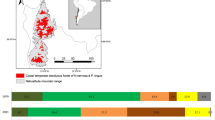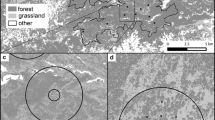Abstract
Calcareous grasslands are among the most species-rich ecosystems in temperate countries. However, these ecosystems have suffered from fragmentation and destruction during the last century. We studied the response of calcareous grassland plant diversity to landscape changes in Belgium. Results indicated that high area loss (since 1965) old habitat patches exhibited an extinction debt inverse to low area loss old habitat patches, little depending on the area loss threshold (60%, 70%, 80% or 90%) considered for the distinction between the high and low area loss patches. However, human activities also created new habitat patches in the landscape and therefore provided opportunities for calcareous grassland plant species to colonize new habitats. This also provided opportunities to study species colonization abilities in the context of habitat restoration. We analyzed species richness in new patches compared to old patches in order to detect colonization credit. We detected the presence of a colonization credit in new patches when using high loss old patches (area loss >80%, exhibiting an extinction debt) or all old patches as a reference. However, when the reference was low loss old patches alone (area loss <80%, less likely to exhibit an extinction debt), no colonization credit was detected. In addition, species composition was similar between new patches and old patches. These results are encouraging for restoration programs. However, the results indicated that the presence of an extinction debt in reference habitats could lead to inaccurate conclusions in restoration monitoring. Therefore, extinction debt should be considered when choosing reference habitats to evaluate restoration success.




Similar content being viewed by others

References
Adriaens D, Honnay O, Hermy M (2006) No evidence of a plant extinction debt in highly fragmented calcareous grasslands in Belgium. Biol Conserv 133:212–224
Arroyo-Mora JP, Sánchez-Azefeifa GA, Rivard B, Calvo JC, Janzen DH (2004) Dynamics in landscape structure and composition for the Chorotega region, Costa Rica from1960 to 2000. Agr Ecosyst Environ 106:27–39
Baudry J, Tatoni T (1993) Changes in landscape patterns and vegetation dynamics in Provence, France. Landscape Urban Plan 24:153–159
Bisteau E, Mahy G (2005) Vegetation and seed bank in a calcareous grassland restored from a Pinus forest. Appl Veg Sci 8:167–174
Bizoux JP, Brevers F, Meerts P, Graitson E, Mahy G (2004) Ecology and conservation of Belgian populations of Viola calaminaria, a metallophyte with a restricted geographic distribution. Belg J Bot 137:91–104
Bizoux JP, Cristofoli S, Piqueray J, Mahy G (2011) Conservation of an endemic metallophyte species: effect of population history and vegetative density on the reproductive success of Viola calaminaria. J Nat Conserv 19:72–78
Bossuyt B, Honnay O (2006) Interactions between plant life span, seed dispersal capacity and fecundity determine metapopulation viability in a dynamic landscape. Landscape Ecol 21:1195–1205
Cousins SAO (2009) Extinction debt in fragmented grasslands: paid or not? J Veg Sci 20:3–7
Cousins SAO, Ohlson H, Eriksson O (2007) Effects of historical and present fragmentation on plant species diversity in semi-natural grasslands in Swedish rural landscapes. Landscape Ecol 22:723–730
Cristofoli S, Mahy G (2010) Colonisation credit in recent wet heathland butterfly communities. Insect Conserv Divers 3:83–91
Cristofoli S, Monty A, Mahy G (2010a) Historical landscape structure affects plant species richness in wet heathlands with complex landscape dynamics. Landscape Urban Plan 98:92–98
Cristofoli S, Piqueray J, Dufrêne M, Bizoux JP, Mahy G (2010b) Colonization credit in restored wet heathlands. Restor Ecol 18:645–655
Delescaille LM (2002) Nature conservation and pastoralism in Wallonia. In: Redecker B, Finck P, Härdtle W, Riecken U, Schröder E (eds) Pasture landscapes and nature conservation. Springer-Verlag, Berlin, pp 39–52
Edwards AR, Mortimer SR, Lawson CS, Westbury DB, Harris SJ, Woodcock BA, Brown VK (2007) Hay strewing, brush harvesting of seed and soil disturbance as tools for the enhancement of botanical diversity in grasslands. Biol Conserv 134:372–382
Fagan KC, Pywell RF, Bullock JM, Marrs RH (2008) Do restored calcareous grasslands on former arable fields resemble ancient targets? The effect of time, methods and environment on outcomes. J Appl Ecol 45:1293–1303
Faucon MP, Parmentier I, Colinet G, Mahy G, Luhembwe MN, Meerts P (2009) May rare metallophytes benefit from disturbed soils following mining activity? The case of the crepidorhopalon tenuis in Katanga (D. R. Congo). Restor Ecol (in press)
Gibson CWD, Brown VK (1992) Grazing and vegetation change: deflected or modified succession? J Appl Ecol 29:120–131
Hanski I (1994) A practical model of metapopulation dynamics. J Anim Ecol 63:151–162
Hanski I, Ovaskainen O (2002) Extinction debt at extinction threshold. Conserv Biol 16:666–673
Helm A, Hanski I, Pärtel M (2006) Slow response of plant species richness to habitat loss and fragmentation. Ecol Lett 9:72–77
Holl KD, Cairns J (2002) Monitoring and appraisal. In: Perrow MR, Davy AJ (eds) Handbook of ecological restoration. Principles of restoration. Cambridge University Press, Cambridge, pp 409–432
Holling CS (1973) Resilience and stability of ecological systems. Ann Rev Ecol Evol Syst 4:1–23
Hutchings MJ, Stewart AJA (2002) Calcareous grasslands. In: Perrow MR, Davy AJ (eds) Handbook of ecological restoration. Restoration in practice. Cambridge University Press, Cambridge, pp 419–442
Jackson ST, Sax DF (2009) Balancing biodiversity in a changing environment: extinction debt, immigration credit and species turnover. Trends Ecol Evol 25:153–159
Jacquemyn H, Butaye J, Hermy M (2003) Influence of environmental and spatial variables on regional distribution of forest plant species in a fragmented and changing landscape. Ecography 26:768–776
Johst K, Brandl R, Eber S (2002) Metapopulation persistence in dynamic landscapes: the role of dispersal distance. Oikos 98:263–270
Jongman RHG (2002) Homogenization and fragmentation of the European landscape: ecological consequences and solutions. Landscape Urban Plan 58:211–221
Jongman RHG, Pungetti G (eds) (2004) Ecological networks and greenways: concept, design implementation. Cambridge University Press, Cambridge, UK
Kiefer S, Poschlod P (1996) Restoration of fallow or afforested calcareous grassland by clear-cutting. In: Settele J, Margules CR, Poschlod P, Henle K (eds) Species survival in fragmented landscapes. Kluwer Academics Publishers, The Netherlands, pp 209–218
Kiehl K, Pfadenhauer J (2007) Establishment and persistence of target species in newly created calcareous grasslands on former arable fields. Plant Ecol 189:31–48
Kiehl K, Thormann A, Pfadenhauer J (2006) Evaluation of initial restoration measures during the restoration of calcareous grasslands on former arable fields. Restor Ecol 14(1):148–156
Krauss J, Bommarco R, Guardiola M, Heikkinen RK, Helm A, Kuussaari M, Lindborg R, Öckinger E, Pärtel M, Pino J, Pöyry J, Raatikainen KM, Sang A, Stefanescu C, Teder T, Zobel M, Steffan-Dewenter I (2010) Habitat fragmentation causes immediate and time-delayed biodiversity loss at different trophic levels. Ecol Lett 13:597–605
Krüger AM, Hellwig FH, Oberprieler C (2002) Genetic diversity in natural and anthropogenic inland populations of salt-tolerant plants: random amplified polymorphic DNA analyses of Aster tripolium L. (Compositae) and Salicornia ramosissima Woods (Chenopodiaceae). Mol Ecol 11:1647–1655
Kuussaari M, Bommarco R, Heikkinen RK, Helm A, Krauss J, Lindborg R, Öckinger E, Pärtel M, Pino J, Rodà F, Stefanescu C, Teder T, Zobel M, Steffan-Dewenter I (2009) Extinction debt: a challenge for biodiversity conservation. Trends Ecol Evol 24:564–571
Lambinon J, Delvosalle L, Duvigneaud J (2004) Nouvelle flore de Belgique du Grand-Duché de Luxembourg du Nord de la France et des régions voisines. Jardin botanique national de Belgique, Meise
Laurance WF (2008) Theory meets reality: how habitat fragmentation research has transcended island biogeographic theory. Biol Conserv 141:1731–1744
Lindborg R (2007) Evaluating the distribution of plant life-history traits in relation to current and historical landscape configurations. J Ecol 95:555–564
Lindborg R, Eriksson O (2004) Historical landscape connectivity affects present plant species diversity. Ecology 85(7):1840–1845
Moilanen A, Nieminen M (2002) Simple connectivity measures in spatial ecology. Ecology 83:1131–1145
Mortimer SR, Hollier JA, Brown VK (1998) Interactions between plant and insect diversity in the restoration of lowland calcareous grasslands in southern Britain. Appl Veg Sci 1:101–114
Palm R (2002) Macros Minitab pour la régression linéaire. Available from http://www.fsagx.ac.be/si/reglin/accueil.htm. Accessed 15th December 2008)
Pärtel M, Kalamees R, Zobel M, Rosén E (1998) Restoration of species-rich limestone grassland communities from overgrown land: the importance of propagule availability. Ecol Eng 10:275–286
Perry G (2002) Landscapes, space and equilibrium: shifting viewpoints. Prog Phys Geog 26:339–359
Piqueray J, Mahy G (2010) Revue bibliographique sur la restauration des pelouses calcicoles en Europe : contraintes rencontrées et solutions proposées. Biotechnol Agron Soc Environ 14:471–484
Piqueray J, Bisteau E, Bottin G, Mahy G (2007) Plant communities and species richness of the calcareous grasslands in southeast Belgium. Belg J Bot 140:157–173
Piqueray J, Bisteau E, Cristofoli S, Palm R, Poschlod P, Mahy G (2011a) Plant species extinction debt in a temperate biodiversity hotspot: Community, species and functional traits approaches. Biol Conserv (in press)
Piqueray J, Bottin G, Delescaille LM, Bisteau E, Colinet G, Mahy G (2011b) Rapid restoration of a species-rich ecosystem assessed from soil and vegetation indicators: the case of calcareous grasslands restored from forest stands. Ecol Indic 11:724–733
Poschlod P, WallisDeVries MF (2002) The historical and socioeconomic perspective of calcareous grasslands: lessons from the distant and recent past. Biol Conserv 104:361–376
Prendergast JR, Quinn RM, Lawton JH, Eversham BC, Gibbons DW (1993) Rare species, the coincidence of diversity hotspots and conservation strategies. Nature 365:335–337
Ricklefs RE (2004) A comprehensive framework for global patterns in biodiversity. Ecol Lett 7:1–15
Saunders DA, Hobbs JA, Margules CR (1991) Biological consequences of ecosystem fragmentation : a review. Conserv Biol 5:18–32
ter Braak CFJ, Smilauer P (2002) CANOCO reference manual and CanoDraw for Windows user’s Guide: software for canonical community ordination (version 4.5). Microcomputer Power, Ithoca, NY, USA
Turner MG (2010) Disturbance and landscape dynamics in a changing world. Ecology 91:2833–2849
Turner MG, Gardner RH, O’Neill RV (2001) Landscape ecology in theory and practice: pattern and process. Springer-Verlag, New York, USA
Vellend M, Verheyen K, Jacquemyn H, Kolb A, Van Calster H, Peterken G, Hermy M (2006) Extinction debt of forest plants persits for more than a century following habitat fragmentation. Ecology 87:542–548
Walker KJ, Stevens PA, Stevens DP, Mountford JO, Manchester SJ, Pywell RF (2004) The restoration and re-creation of species-rich lowland grassland on land formerly managed for intensive agriculture in the UK. Biol Conserv 119:1–18
WallisDeVries MF, Poschlod P, Willems JH (2002) Challenges for the conservation of calcareous grasslands in northwestern Europe: integrating the requirements of flora and fauna. Biol Conserv 104:265–273
Acknowledgments
This work was undertaken as part of the project “Development and test of a methodology for the elaboration of Natura 2000 sites designation acts”, funded by the Walloon Public Service (DGARNE-DNF). This study was supported by the FRS-FNRS (contract FRFC 2.4556.05).
Author information
Authors and Affiliations
Corresponding author
Rights and permissions
About this article
Cite this article
Piqueray, J., Cristofoli, S., Bisteau, E. et al. Testing coexistence of extinction debt and colonization credit in fragmented calcareous grasslands with complex historical dynamics. Landscape Ecol 26, 823–836 (2011). https://doi.org/10.1007/s10980-011-9611-5
Received:
Accepted:
Published:
Issue Date:
DOI: https://doi.org/10.1007/s10980-011-9611-5



